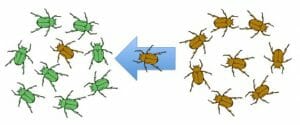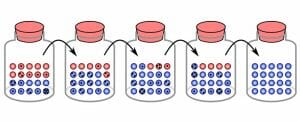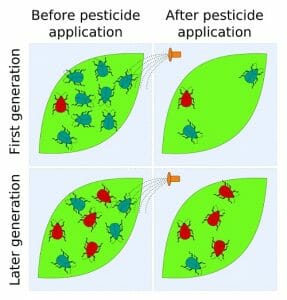Microevolution Definition
Microevolution is defined as changes in allele frequency that can be observed within a population.
In contrast to macroevolution, microevolution can be observed and measured in short periods of time, even within a single generation; macroevolution refers to the large-scale differences that can be observed between different species.
An accumulation of changes resulting from microevolution will eventually lead to macroevolution through the process of speciation. In this way, they are essentially the same process, although on a different time scale.
Processes of Microevolution
There are several ways in which microevolution can take place:
Gene Flow
Also known as “gene migration’, gene flow is the transfer of alleles (variants of a gene) from one population to another. Gene flow occurs when individuals or their gametes are able to migrate between populations that are physically separated. For example, a person moving to a new country is adding to the gene pool of that country’s population. Plants and fungi could have their pollen and spores distributed to another population by wind, pollinators or other mechanisms. In each gene flow event, the frequency of alleles present in each population is slightly altered.

Usually gene flow is restricted to populations of the same species due to the barriers imposed by reproductive isolation. There are exceptions, however, such as the mechanisms employed by bacteria and viruses to transfer genes between organisms through horizontal gene transfer. In some cases, gene flow can occur between separate species, although generally only those that are closely related. If the two species have diverged recently, they may be able to produce offspring; however, these offspring are commonly infertile. Examples include the infertile ‘mule’ produced from a mating event between a donkey and a horse, or the ‘liger’ and ‘tygon’ resulting from the mating between a lion and a tiger.
Gene flow is a significant barrier to speciation; where gene flow is frequent between populations and the gene pools are regularly shuffled, the two populations do not have an opportunity to become genetically distinct.
Gene flow can also increase the genetic diversity of a population. For example, if an allele that has evolved within population B is introduced to population A, the genetic diversity of population A increases.
Genetic Drift
Genetic drift is the process of microevolution that describes the random fluctuations in the frequency of alleles within a population.
Variants of genes (alleles) will become more or less numerous in a population if, by random chance, more copies of certain genes are passed on to the offspring generation. For example, if there are individuals with blue and red genes and, by chance, more individuals with blue genes reproduce, there will be more individuals with blue genes in the next generation. The frequency of blue genes may continue to increase in the following generations due to the chance of them being passed on to the offspring.
Genetic drift can lead to 100% fixation of an allele variant, or to it being lost entirely, both of which can result in a lower overall genetic diversity of the population. This is more likely in a small population and is common after population bottlenecks, in which case the rare alleles of the population can be lost rapidly.
Additionally, the founder effect, in which a small number of individuals becomes separated and isolated from a population, can cause genetic drift. The new population of individuals contains a limited sample of the full diversity of alleles in the original population, which will then increase in frequency.

The image shows the probability chance of each gene being passed from parent to offspring through several generations.
In this case of microevolution, environmental or adaptive pressures do not determine the change in the frequency of allele variants in the population. The change is determined by random chance, and therefore the changes may be positive, negative or neutral for survival.
Mutation
Mutations are the ultimate cause of all variation in genetic diversity and the only source of new alleles. Although they occur rarely, a range of different circumstances, such as radiation, viruses and mutagenic chemicals, may cause them. They also occur naturally, as errors during DNA replication or meiosis.
A mutation may alter the outcome of the trait that the gene codes for, or it may prevent the gene from functioning correctly. However, mutations often have no effect or are only mildly deleterious (harmful), although they can also be advantageous. If the mutation is advantageous to the point where it gives the organism an adaptive advantage in an environment, it is likely to spread through the population through the process of natural selection, eventually leading to macroevolution.
The spread of mutated alleles can be even more rapid if they are dominant alleles, since their effects are shown immediately in the heterozygous and homozygous forms.
Selection
The natural selection of alleles that control for certain traits occurs when an organism’s gene variants give it an adaptive advantage over the other gene variants in a population, ultimately allowing it to reproduce and increase the frequency of these genes.
Another way that alleles may be selected for is through sexual selection. In microevolution through sexual selection, organisms choose their mating partner based on an arbitrary feature that does not necessarily make them better adapted to their environment but that makes them more attractive to the opposite sex, for example, bright eyespots on a peacock’s tail or large heavy antlers on a deer. Displaying the desired trait gives the mate a competitive advantage in reproduction, and eventually leads to an increase in the frequency of alleles associated with that trait.
Selection may also be controlled through artificial selection by humans. In this case, which is similar to sexual selection, certain desirable physical or behavioral traits of a plant or animal are chosen, and individuals that possess them are bred. The alleles become more common as a by-product of selecting for the favorable trait, even if it does not benefit the organism’s survival.
Examples of Microevolution
Pesticide Resistance
Pesticides are designed to kill insects that might feed on a particular plant. Each time the pesticide is applied to the plant, a few individuals may survive, including those possessing certain genes that cause resistance to the pesticide.
The surviving individuals will go on to reproduce and increase the frequency of the genes that enabled them to survive in the population. Through subsequent applications of the pesticide, the number of individuals that have the genes for resistance will increase to complete fixation; at this point, the pesticide cannot kill any of the individuals, as they are all resistant. This means a new pesticide must be developed to kill future generations of insect.
The mechanisms of microevolution occurring here are natural selection and genetic drift by means of a bottleneck.

Evolution of Viral Disease
Although they are a highly diverse group, viruses comprise several prerequisites in their biology that render them particularly susceptible to rapid microevolution.
Unlike other organisms, viruses may store their genetic information using either DNA or RNA. Mutation rates during replication are much higher in RNA than in DNA and therefore new genes, which may be beneficial to the organism and increase in frequency through selection, are created more frequently. Viruses also have large population sizes and short generation times, which further increases the probability of a possible genetic mutation and allows mutations to spread rapidly through populations.
Additionally, some viruses, such as influenza and HIV, can ‘shuffle’ their genes with other strains of the virus in a process called recombination. This can lead to the evolution of entirely new viral strains and greatly increases the genetic diversity of the population.
The constant emergence and microevolution of viruses due to their high mutation rate makes them incredibly hard to treat when they infect other animals, as the populations can quickly develop resistance to drugs.
Quiz
1. Which of the following processes of evolution results in new gene variants?
A. Gene flow
B. Genetic Drift
C. Mutation
D. Natural Selection
2. What effect does a consistent rate of gene flow have on populations?
A. It speeds up speciation
B. It prevents speciation
C. It decreases genetic diversity
D. It increases mobility between populations
3. Pesticide resistance is caused by:
A. High mutation rates in insect genomes
B. A population bottleneck
C. Gene flow
D. Large numbers of insects
References
- University of California Museum of Paleontology. (2017) Mechanisms of microevolution. In Understanding Evolution. Retrieved from http://evolution.berkeley.edu/evolibrary/article/0_0_0/evo_39
- Population Genetics (2017) University of Miami. Retrieved from:http://www.bio.miami.edu/tom/courses/bil160/bil160goods/04_popgen.html
- Evolutionary Biology/Microevolution (2013) Wikibooks. Retrieved from:https://en.wikibooks.org/wiki/Evolutionary_Biology/Microevolution
- Duffy, S. Shackelton, L. Holmes, E. (2008) Rates of evolutionary change in viruses: patterns and determinants. Nature Reviews Genetics. 9: 267-276
- Manrubia, S. Lázaro (2006) Viral evolution. Physics of Life Reviews. 2006. 65-92
- Evolution of viruses / viruses. (2017) Khan Academy. Retrieved from:https://www.khanacademy.org/science/biology/biology-of-viruses/virus-biology/a/evolution-of-viruses
